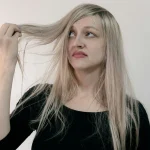Hair comes in all shapes and forms, and that’s an undeniable truth. Straight, wavy, thick, fluffy, glass-like – each type unique and captivating in its own way. Yet, sometimes, our hair can start behaving in the most unusual manner, from breaking in one spot to twisting, thinning, or sprouting in clumps. These unexpected changes may cause worry, but they shouldn’t automatically prompt you to grab the scissors. However, ignoring such signals may not be wise either, as what might seem like mere quirks could signal deeper, health-related conditions, or be indicative of your individual hair characteristics.
The Intricacies of Hair Form: Flattened, Twisted, or Clump-Growing Strands
Flattened hair is an infrequent but intriguing trait, where the cross-section of the hair isn’t perfectly round but slightly squished. This can make the hair appear thinner and less apt to hold a style, but from a health perspective, it’s usually harmless. This characteristic is most commonly found in individuals of Asian and Latin American descent and doesn’t bring discomfort, making it a perfectly natural trait.
Twisted hair takes on a unique spiraling pattern, coiling around itself, which results in fragility. These hairs are often prone to breaking at the point where they twist. It can be a genetic trait or a result of deficiency in copper, Menkes syndrome, or certain dermatological conditions. Although it may seem concerning, it is typically not a health threat and, for children, may normalize with time and proper care.
Clump-growing hair is a rarer phenomenon where one follicle produces not one, but multiple hairs—sometimes up to 40. While this might look like small dark spots on the scalp, it’s often harmless and mostly aesthetic in nature. This trait is most commonly seen in men and is not a clinical anomaly.
Spiked hair, another congenital feature, is marked by a hair shaft that thickens at the base and tapers to a finer tip. This form is often indistinguishable from regular hair and doesn’t impact health, although it is an uncommon pattern to observe.
Common Hair Complaints: Thinning and Breakage
Thinning hair refers to when strands gradually become finer, yet still appear somewhat normal on the surface. This condition is often linked with aging as the process of thinning progresses slowly and may go unnoticed at first. It can be associated with overall health issues such as chronic diseases, stress, restrictive diets, or vitamin deficiencies like iron deficiency or hypothyroidism. Hair follicles receive less nourishment, and thinning often leads to shedding and eventual baldness. This condition is frequently observed in women suffering from seborrhea or hormonal imbalances.
Split ends (trichoptilosis) are a widespread issue, especially for those with longer hair. These occur due to mechanical damage, repeated exposure to heat styling tools, and the drying effects of high-temperature blow drying. The root cause of this problem is dryness, which leads to a lack of lipids in the hair cuticle.
Trichoclasia (brittle hair) manifests in two forms: transverse breakage, where the hair snaps like dry twigs, and longitudinal splitting, where the hair splits along its length. This is usually the result of reduced scalp moisture and decreased sebum production, often stemming from vitamin deficiencies or anemia. Such conditions lead to excessive dryness, causing the sebaceous glands to underperform.
Knotted hair occurs when small tangles form along the hair shaft, usually toward the bottom third of the strands. These knots can be numerous and often break when combed. The primary causes of this condition include excessive friction, rough combing, overly intense scalp massages, and insufficient nourishment for the hair shafts. It’s especially common for those with curly or porous hair.
Addressing the Root Causes: Why Do These Conditions Occur?
These various hair conditions often overlap and may present simultaneously due to their shared underlying causes. Factors like poor nutrition, stress, and inadequate hair care can exacerbate these anomalies. It’s essential to remember that any hair can be brought back to its genetic maximum potential. This is not a fairy tale—it’s achievable. Your hair health begins with how you care for it—and, equally important, how you care for yourself.
Author’s note: Materials sourced from reputable medical resources such as PubMed, Journal of Dermatological Science, and International Journal of Trichology. All information provided is for educational purposes and does not replace professional medical advice.







